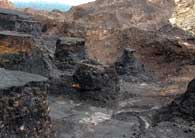Remining
for Abandoned Mine Reclamation
Note: The content on this page is available as a tri-fold brochure in PDF format.
 Remining is any subsequent mining operation at a site that had previously
been mined. It is often done through cooperation between private energy companies
and local community groups. A win-win situation results from allowing coal
operators to extract remaining coal for its value in exchange for reclamation
of the remined sites.
Remining is any subsequent mining operation at a site that had previously
been mined. It is often done through cooperation between private energy companies
and local community groups. A win-win situation results from allowing coal
operators to extract remaining coal for its value in exchange for reclamation
of the remined sites.
Introduction
Pennsylvania has a quarter of a million acres of land that were mined and abandoned before the Surface Mining Control and Reclamation Act (SMCRA) became law in 1977. These abandoned mine lands include deadly mine openings, 187 total miles of dangerous highwalls, and enormous piles of waste coal. They also produce abandoned mine drainage—the largest water pollution problem in the Commonwealth.
SMCRA mandates that mining companies reclaim all post-1977 mining and remining operations to a safe, nonpolluting condition. For companies involved in remining, this includes removing any highwalls or waste coal piles that had already existed. As such, remining has proven to be a very valuable tool in addressing Pennsylvania's abandoned mine land problems. It also alleviates acid mine drainage, which emanates from unreclaimed, abandoned mines and pollutes streams.
Types of Remining
Daylighting is an remining technique that surface mines the coal left behind by old, deep mining operations. Many decades ago, underground miners had to leave large pillars of coal untouched to support the rock layers overhead, so the mine roof would not collapse. As a result, as much as 50% of the coal remains as pillars in abandoned underground mines. Daylighting removes the mine roof altogether and recovers the remaining coal.

Enormous piles of waste coal litter Pennsylvania's landscape, degrading the environment and sinking property values in coal communities. Although the coal remaining in these piles has less energy content than traditionally-mined coal, it can be burned efficiently and cleanly in specialized power plants using circulating fluidized bed (CFB) technology.
Waste coal reclamation with circulating fluidized bed boilers is addressed in a separate WPCAMR publication, Burning Waste Coal in CFB Power Plants.
Remining Permits and Incentives
As with all coal mining, remining is regulated by the Commonwealth. The most straightforward remining processes use Government Financed Construction Contracts (a misnomer since the state pays nothing) or traditional Surface Mining Permits. In both cases, the mining company is required to reclaim the area to federal standards.
Besides these permits, the Pennsylvania legislature has passed incentives to encourage privately-funded reclamation through remining:
- Pre-existing AMD discharges
- Traditionally, remining companies would avoid sites with pre-existing abandoned mine drainage, because they would have to accept full perpetual liability to treat it. "Subchapter F and G" permits and "remining NPDES permits" allow the remining of areas that are hydrologically connected to existing AMD discharges with no liability, as long as remining does not make the discharge worse. This incentive has allowed remining of 300 sites, most of which actually improved water quality.
- Original contour variance
- Whereas surface mining permits usually require restoring land to its approximate original contour, remining operations may use alternate backfilling methods, such as terracing. This reduces reclamation costs while still accommodating productive land use after mining.
- Alkaline ash
- Ash from waste coal combustion in circulating fluidized bed power plants can neutralize acid and is well-suited for mine reclamation projects. It is often hauled back for reclamation to the same site where remining occurred. Pennsylvania has certified this type of ash for beneficial use in mining reclamation projects, and the DEP regulates and routinely tests it.
Team Up for Remining
 Remining might be able to help clean up your watershed if there are AMD
discharges that come from sources of left-behind coal. However, remining
is not always possible due to geologic constraints or not being economically
wise for a mining company.
Remining might be able to help clean up your watershed if there are AMD
discharges that come from sources of left-behind coal. However, remining
is not always possible due to geologic constraints or not being economically
wise for a mining company.
To make remining work for you, contact the Watershed Manager at your DEP District Mining Office. If possible, have a basic project plan ready. The Watershed Manager can help explore strengths and limitations of the project and find opportunities for subsidies.
WPCAMR
Formed in 1982, the Western Pennsylvania Coalition for Abandoned Mine Reclamation is a non-profit, non-partisan, local, state, federal, and industry partnership dedicated to improving the local economy and enhancing the quality of life reclaiming the abandoned mine lands and degraded waters of Western Pennsylvania.
A coalition of 24 county conservation districts, WPCAMR's efforts expand into areas where reclamation is limited, showing local communities that their polluted lands can be clean and giving people hope where little existed in the past.